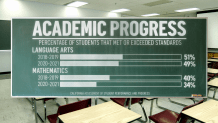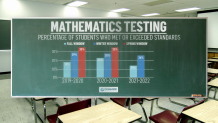It’s been nearly two years since millions of students were first forced out of local schools due to the COVID-19 pandemic. Since then, many wondered whether online learning slowed academic progress and, if so, by how much.
Answering that question proved hard to come by, because in light of the virus, California skipped its statewide assessments for the school year 2019-20. Last month, though, the California Department of Education released 2020-21's results, giving state educators their first real glimpse into statewide COVID-19 learning.
The data shows academic progress slowed across the board during the 2020-21 school year compared with 2018-19, with younger students especially experiencing a wider academic gap.
Get San Diego local news, weather forecasts, sports and lifestyle stories to your inbox. Sign up for NBC San Diego newsletters.
Chronic absenteeism was also up. Fourteen percent of California students missed 10% or more school days last year (a 2% increase).

San Diego single mother Jessica McClure often traveled for work before the pandemic but found herself working from home in 2020. She shared that space with her 7-year-old son, who was similarly forced to stay home as a student in the Poway Unified School District. McClure noticed early on that her son, who is dyslexic, was having a hard time with online learning.
Local
“It was super eye-opening for me because I don’t think I realized how much he struggled until it was me in front of him,” McClure said.
With guidance from her son’s teachers, she started doing interactive lessons with her son one-on-one. McClure said she noticed a big change for the better. A question still lingered in her mind: “Was her son falling behind?”
“You know I struggle with that thought,” McClure said. “Because obviously all the parents talk about that on a regular basis. Do we have a gap now? Is there something that we lacked because of the way that things turned out?”
Mercedes Lovie, an associate superintendent of the Oceanside Unified School District, told NBC 7: “It has changed everything about education.”
Oceanside Unified tests students internally three times a year, including the year the state skipped testing. The district said it discovered students fell behind in math but stayed relatively on track in language arts. Lovie said it’s easier for students to reinforce language skills outside of the classroom.
“I think there are more opportunities for reading to be in the natural environment,” Lovie said.

In response to the lower testing scores in mathematics, the district said, it’s rethinking its curriculum, offering professional training for teachers and looking at new textbooks. In addition to these efforts, the district is allowing high school students to make up credits to help them stay on track for graduation. Oceanside also offered virtual on-demand tutoring assistance and employed intervention teachers.
Teachers told NBC 7 that the pandemic has other surprising effects as well. Virtual education allowed teachers to see inside their students’ home environments, often for the first time.
“Those little windows in their life that you wouldn’t see in a classroom led to a lot,” Oceanside Teachers Association president Tiffany Cooper-Ortega said.
Cooper-Ortega said that not all children had a proper learning/workspace at home, with desks, pencils and pens. Some students worked on couches in their living room, on coffee tables or even on the floor. Educators didn’t realize some students needed school supplies. They also realized a need for emotional support resources and education. Oceanside now boasts a full-time mental health counselor at every elementary school in its district and has a social emotional learning curriculum for all students.
“Teachers have always worried about students,” Cooper-Ortega said. “They’ve always lost sleep at night, worrying if students are going to make grade level, if they’re going to achieve academic success. What was different about it wasn’t that we were feeling it and it was new, it was that we were all feeling it at one time. It was a universal feeling. Everyone was worried about what students were learning.”
Other than the academic efforts to bring students back on track, Oceanside Unified recently opened four “community schools” for its most at-risk students. These schools provide food, health and other resource clinics for students' families.
“But what we’ve also seen is children are amazingly resilient,” Lovie said.



